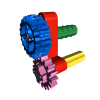
[NEW PART] ≥3 drive axles through a Lego Technic turntable | The fin
By
896gerard, in LEGO Technic, Mindstorms, Model Team and Scale Modeling
-
Recently Browsing 0 members
No registered users viewing this page.
